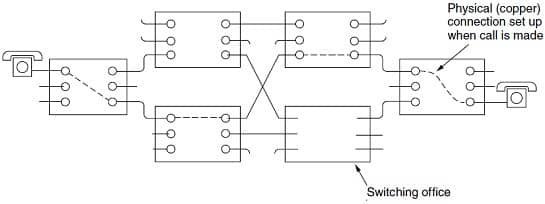Define Switching in Networking
Define Switching in Networking: From the point of view, an ordinary telephone operator, a telephone system is divided into two main parts:
- Outside Plant (local loops and trunks because they are physically located outside the switch rooms).
- Inside Plant (switches located inside the exchange points).
Currently, the network uses two different switching methods:
- Circuit Switching
- Packet Switching
A traditional telephone system is based on circuit switching, but packet switching is beginning to risk the development of voice over IP technology.
Circuit Switching
Define Switching in Networking with the circuit switching. Conceptually, when you or your computer make a phone call, the telephone system switch equipment searches for a physical route between your phone and the recipient’s phone. This technique is called circuit switching.

Each of the six rectangles represents a point of change of operator (end office, toll office, etc.). In this example, each office has three incoming lines and three outgoing lines. When a call goes through a switching point, a physical connection (conceptual) is established between the line on which the call was received and one of the outgoing lines, indicated by dashed lines.
An important property of channel switching is the need to configure an end-to-end route before sending data. The time between the end of a call and the start of a call can easily be 10 seconds, longer for long-distance or international calls. During this time, the phone system looks for a path. Please note that before starting the data transfer, the call request signal must be sent to the destination and acknowledged. For many computer applications (for example, point-of-sale credit check or verification), long installation time is not desirable.

Packet Switching
Define Switching in Networking with the packet switching. An alternative to circuit switching is packet switching.

Thanks to this technology, parcels are delivered immediately after their arrival. There is no need to preconfigure a dedicated route, as opposed to a channel change. Routers must use storage transfer and forwarding to send each packet on its way to the destination. This procedure differs from circuit switching in which the result of configuring the connection is to reserve the bandwidth of the sender to the recipient. All the circuit data follows this path. Among the other properties, the presence of all data on the same route means that they cannot be decommissioned. When switching packets, there is no fixed route, so different packets may follow different routes depending on the state of the network at the time of sending and may fail.
Packet-switched networks impose a strict upper limit on the size of packets. This ensures that no user can monopolize a transmission line for a long time (for example, several milliseconds), so that switched packet networks can handle interactive traffic. This also reduces the delay because the first packet of a long message can be returned before the second one has completely arrived. However, the storage and transmission delay when a packet is accumulated in the router’s memory before sending it to the next router exceeds the channel switchover time. When switching circuits, the bits simply cross the cable continuously.

Packet and channel switching is also different in other respects. Since bandwidth is not reserved for packet switching, it may be necessary to wait for packets to be forwarded. This causes a delay and congestion of the queue if a packet is sent at the same time. On the other hand, there is no danger of receiving a busy signal and the inability to use the network. As a result, congestion occurs at different times during circuit switching (during configuration) and packet switching (when sending packets). If a channel has been reserved for a specific user and there is no traffic, its bandwidth is lost. It cannot be used for other traffic.
Packet switching does not waste bandwidth and is, therefore, more efficient from the point of view, of the system. Understanding this compensation is essential to understanding the difference between circuit switching and packet switching. The compensation is between the guaranteed service and the waste of resources, not a guarantee of service and not a waste of resources.
Packet switching is more fault-tolerant than circuit switching. That’s why it was invented. If the switch goes down, all channels that use it are terminated and no one else can send traffic. Packet-switched packets can be routed around inactive switches.
The final difference between circuits and packet switching is the boot algorithm. With circuit switching, the load has always been based on distance and time. In general, in the case of mobile phones, distance matters little, except for international calls, and time plays a vital role (e.g., a calling plan with 2000 free minutes’ costs more than one with 1000 free minutes and sometimes nights or weekends are cheap).
With packet switching, connection time is not a problem, but the amount of traffic. For home users, Internet service providers generally charge a flat monthly fee because they require less work and their customers can understand this model, but backbone operators charge regional networks based on the volume of their traffic.


